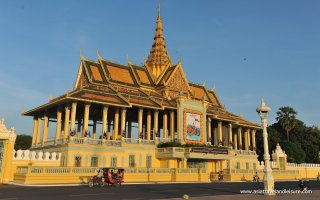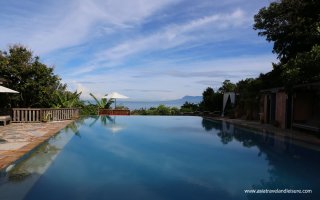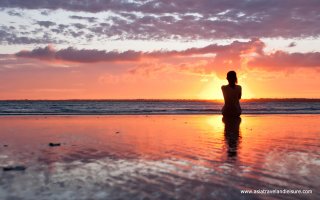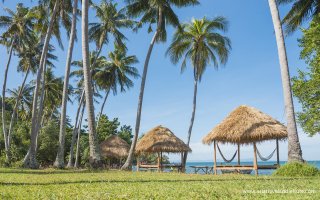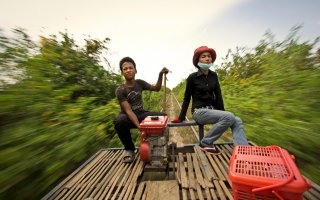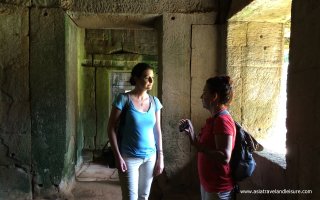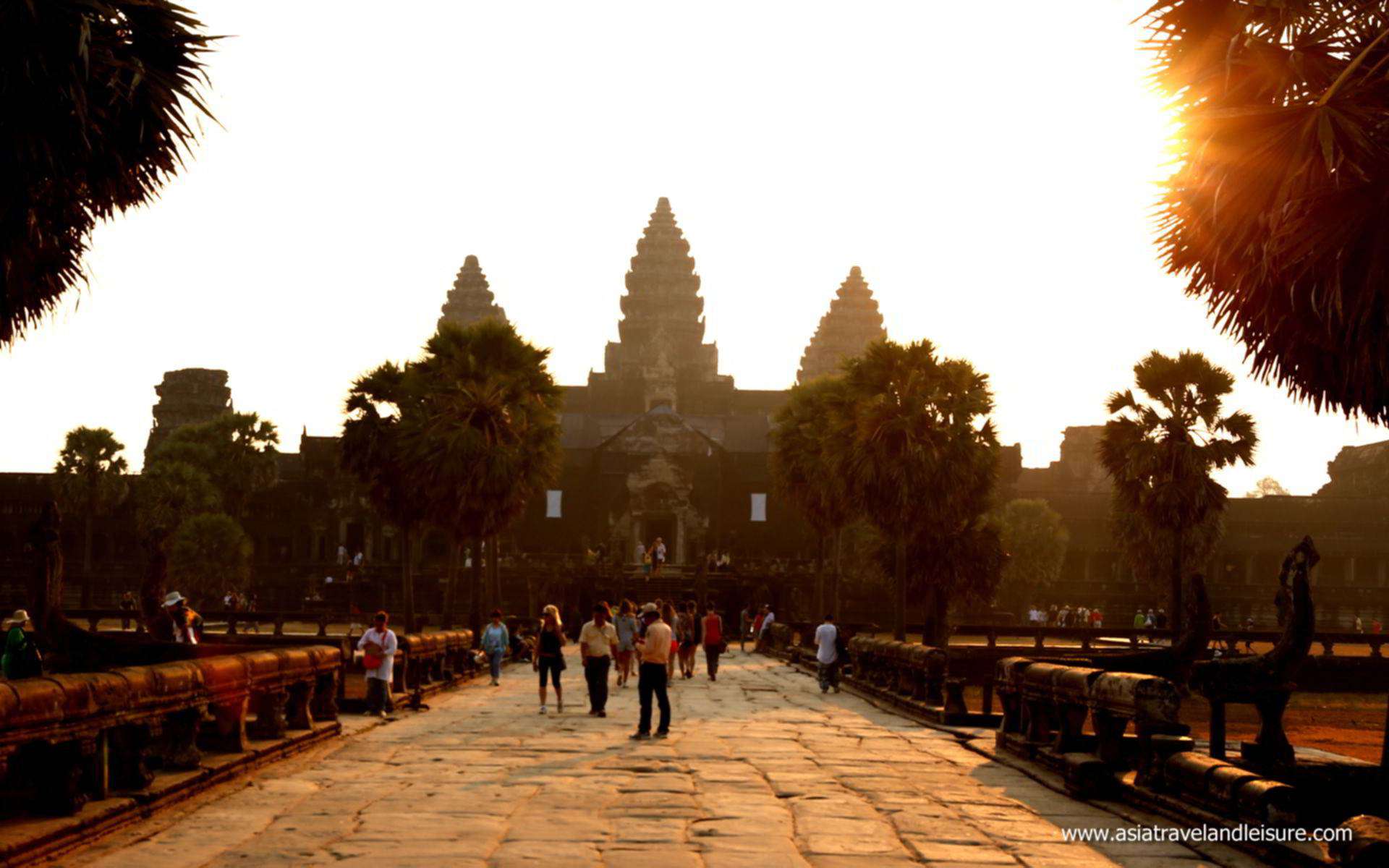
1. Siem Riep - A must-visit place in cambodia
Siem Reap, the gateway to the ancient world, invites travelers to step back in time to explore the ruins of Angkor, once the heart of the Khmer empire. This city is a tapestry of cultural heritage and modern-day Cambodian life, making it a fascinating destination for those seeking to uncover the mysteries of the past while experiencing the vibrant present.
The majestic Angkor Wat stands as the pinnacle of Khmer architecture and is a symbol of Cambodia's national pride. Alongside this iconic temple, the ancient city of Angkor Thom and the enigmatic faces of Bayon Temple offer an unforgettable journey through history. As the sun sets, the lesser-known but equally captivating Pre Rup temple provides a serene spot to witness the day's end.
For those looking to delve deeper into the local culture, Siem Reap offers bustling night markets where artisans showcase their crafts and street food vendors serve up local flavors. The nearby floating villages on Tonle Sap Lake present a unique way of life, with opportunities for visitors to engage with the community and learn about their traditions.
Siem Reap is a treasure trove for history enthusiasts, spiritual seekers, and cultural adventurers. Whether you're marveling at the grandeur of ancient temples, sampling Cambodian cuisine, or wandering through lively markets, Siem Reap promises an enriching experience that resonates with the soul of every traveler.
To truly immerse yourself in the wonders of Siem Reap, consider the Siem Reap & Battambang - 7 Days tour, which promises a blend of cultural exploration and excursions in the peaceful countryside of Cambodia. This journey takes you through the heart of Cambodia, from the iconic Angkor temples to the charming city of Battambang, where you can experience the unique 'bamboo train' and connect with the local way of life
For those seeking a more adventurous route, the Siem Reap Discovery - 6 Days tour offers an alternative path less traveled. It leads you to culturally rich villages and remote Angkor temples veiled by the jungle, providing an intimate glimpse into Cambodia's heritage and natural beauty. Both tours encapsulate the spirit of discovery that Siem Reap is celebrated for, ensuring memories that will last a lifetime.
Need a brief insight into Siem Reap? Here's a quick rundown to fulfill your curiosity
- Top Attractions: Angkor Wat (the crown jewel!), Angkor Thom complex (including Bayon Temple with its many smiling faces), Ta Prohm temple (embraced by nature), Banteay Srei (temple with intricate carvings), and the Tonle Sap (largest freshwater lake in Southeast Asia).
- Safety: Generally safe for tourists with basic precautions.
- Best Time to Visit Siem Reap: November to March offers pleasant weather, but expect crowds. Alternatively, May to June offers fewer crowds with hotter temperatures.
- Activities: Explore magnificent temples, discover the Angkor Empire's rich history, take a boat trip on Tonle Sap, enjoy a traditional Apsara dance performance, or visit a local village.
- Accommodation: Options range from luxurious boutique hotels to budget-friendly guesthouses.
- Getting Around: Tuk-tuks, taxis, and ride-hailing apps are convenient choices. Bicycles are also a great way to explore the town itself.
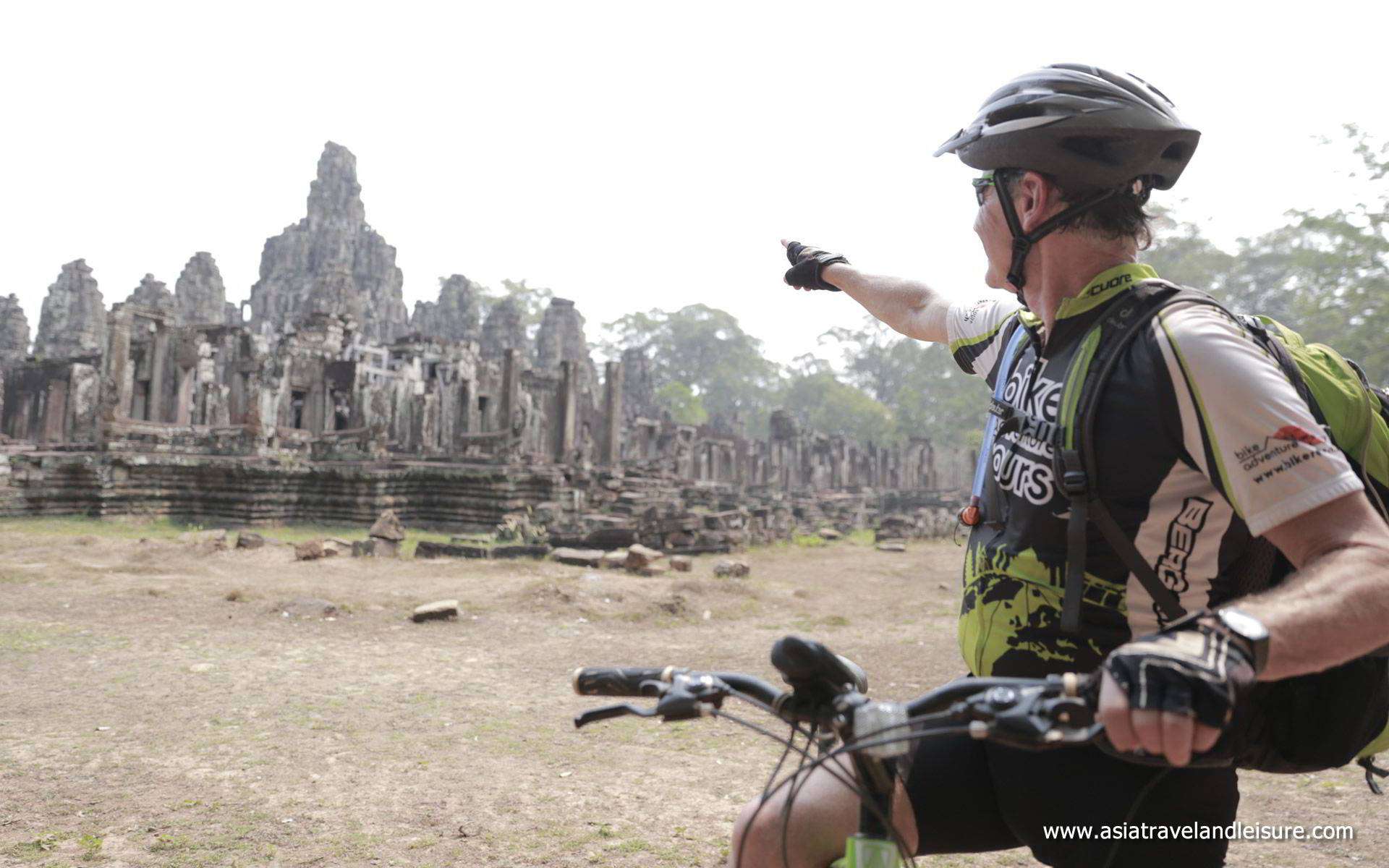
2. Angkor Wat
Nestled in the heart of Cambodia, Angkor Wat stands as a pinnacle of Khmer architectural achievement and spiritual devotion. Constructed in the early 12th century, this temple complex was originally dedicated to the Hindu god Vishnu, reflecting the empire's religious beliefs of the time. Today, it is a revered icon of Cambodia's cultural heritage and attracts millions of visitors from around the globe.
As you approach Angkor Wat, the sheer scale of the complex becomes apparent. The outer moat, symbolizing the mythical oceans, encircles the temple, leading to a long causeway that ushers visitors into a world of historical splendor. The central quincunx of towers, designed to represent the peaks of Mount Meru, rises into the sky, a testament to the ancient Khmer's astronomical and religious knowledge.
The walls of Angkor Wat are adorned with extensive bas-reliefs, depicting scenes from Hindu epics such as the Mahabharata and the Ramayana, as well as historical events of the Khmer Empire. These carvings not only showcase the artisans' skill but also serve as a historical record, providing insight into the daily life and beliefs of the Khmer people.
Exploring Angkor Wat is akin to stepping back in time. Each gallery, courtyard, and tower tells a story, inviting visitors to ponder the legacy of Khmer empire. Whether witnessing the first rays of sunlight casting a golden hue over the temple or marveling at the intricate artistry of the carvings, a visit to Angkor Wat is an unforgettable journey through history and spirituality.
For an immersive experience, visitors can explore the vast galleries, witness the detailed bas-reliefs, and watch the sunrise from behind the temple—a truly breathtaking sight. The best time to visit Angkor Wat is between November and February when the weather is cooler and drier, making it ideal for exploring the expansive site.
Travelers should come prepared with comfortable shoes for the extensive walking required and adhere to the dress code by covering shoulders and knees, out of respect for the temple's cultural significance.
3. Phnom Penh
Phnom Penh, the vibrant capital of Cambodia, thrums with a unique energy. Steeped in history, it's a city of contrasts, where ancient temples share the skyline with modern cafes. Wondering if Phnom Penh deserves a spot on your Cambodian itinerary? Let's delve into what piques travellers' interest the most.
Safety is a top concern, and Phnom Penh is generally considered safe for tourists. It's a bustling metropolis, so common-sense precautions apply. Phnom Penh boasts a treasure trove of sights. The Royal Palace and Silver Pagoda shimmer with grandeur, while the Tuol Sleng Genocide Museum and Killing Fields offer a poignant look into Cambodia's past.
Adventurous foodies will be spoilt for choice. From steaming bowls of noodles on street corners to delectable French cuisine, Phnom Penh's food scene is a delightful fusion of cultures. Those seeking luxurious escapes will find a haven in Phnom Penh's high-end hotels and spas. Family-friendly options abound too, with cooking classes and explorations of the city's lively markets keeping everyone entertained.
At roughly 314 kilometers (approximately 195 miles), Phnom Penh and Siem Reap are connected by a 5.5 hour road trip. While flights offer a much faster option, clocking in at just 45-50 minutes for direct journeys, their high cost makes them impractical for day trips from Phnom Penh to Siem Reap. But you can take day trips to nearby attractions:
- Royal Palace.
- Wat Phnom.
- Phnom Penh Independence Monument.
- Tuol Sleng Genocide Museum (S-21)
- Wat Ounalom.
- Choeung Ek Genocidal Center (Choeung Ek Killing Fields)
- Silver Pagoda (Wat Preah Keo)
- Phnom Penh Central Market (Phsar Thmey)
Whether you're a history buff, a culture vulture, or simply a curious explorer, Phnom Penh has something to offer everyone. So, pack your bags and get ready to discover this captivating city!
Here's a quick rundown to quench your curiosity about Phnom Penh:
- Top Attractions: Majestic Royal Palace and Silver Pagoda, chilling Tuol Sleng Genocide Museum and Killing Fields, bustling Phnom Penh Central Market, and the iconic Independence Monument.
- Safety: Generally safe for tourists with basic precautions.
- Best Time to Visit Phnom Penh: November to March offers pleasant weather, though the city buzzes year-round.
- Activities: Explore architectural wonders, delve into Cambodia's dark past, savor delectable cuisine with a cooking class, experience lively nightlife, or take a family-friendly trip to the Phnom Tamao Wildlife Rescue Center.
- Accommodation: Options range from luxurious riverside hotels to budget-friendly guesthouses.
- Getting Around: Tuk-tuks, taxis, and ride-hailing apps like PassApp are convenient choices. Day trips to Siem Reap, home to Angkor Wat, are popular as well.
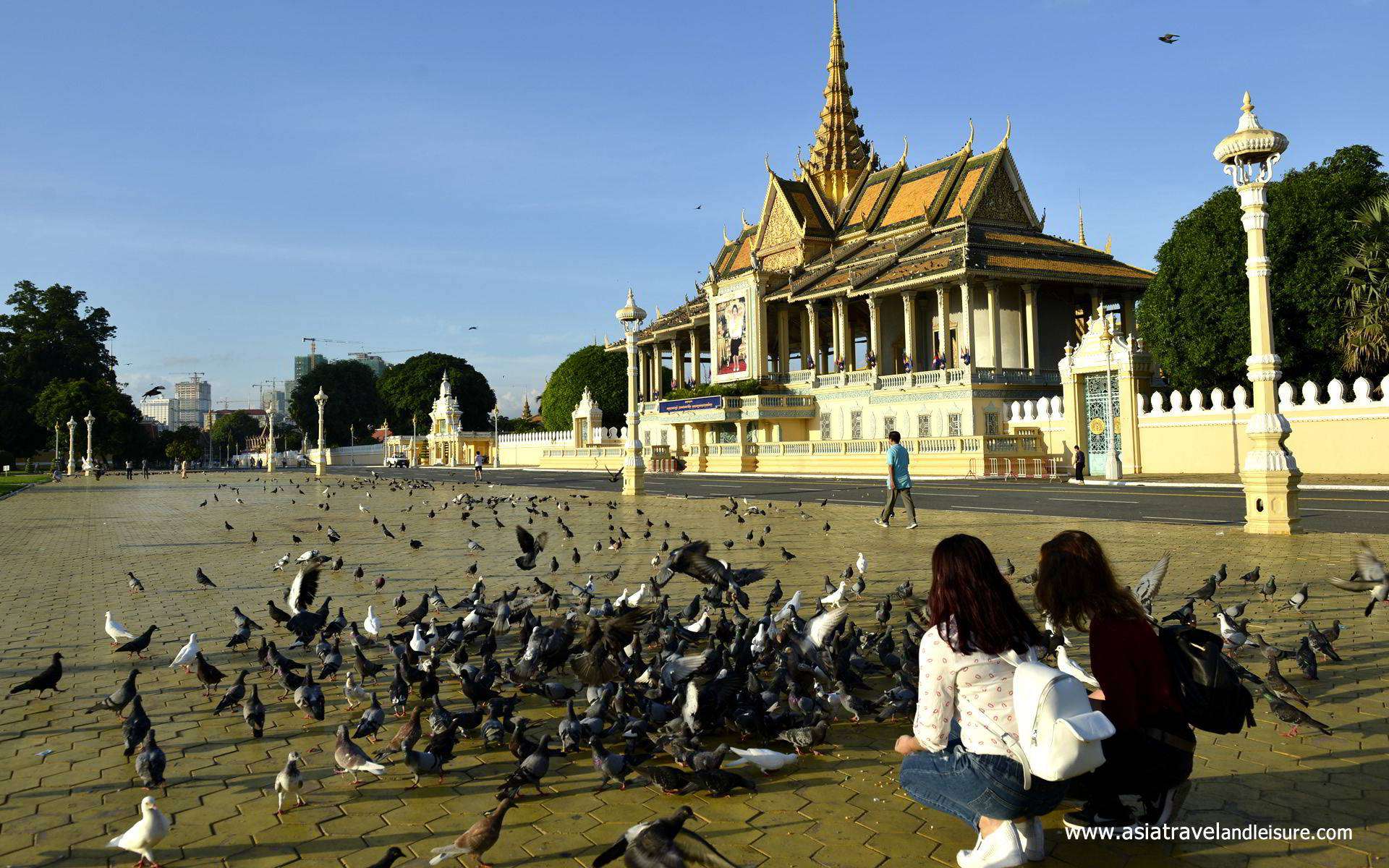
4. Sihanoukville
Sihanoukville, also known as Kampong Som, is a vibrant coastal city in Cambodia that offers a unique blend of traditional charm and modern attractions. Renowned for its stunning beaches, such as the golden sands of Ochheuteal Beach and the serene Otres Beach, the city is a haven for beach lovers and water sports enthusiasts alike. Visitors can indulge in activities like sunbathing, swimming, snorkeling, and scuba diving, or simply relax at the beachfront cafés sipping tropical drinks while enjoying panoramic views.
The best time to visit Sihanoukville is between November and February, when the weather is most favorable for beach activities and exploring the city's attractions. Getting to Sihanoukville is straightforward, with options ranging from flights to the local airport to buses and taxis from major cities like Phnom Penh. Once in the city, tuk-tuks and motorcycle taxis offer an authentic and convenient way to navigate the bustling streets and scenic coastline.
For families, beaches like Otres provide a more laid-back atmosphere, perfect for building sandcastles or enjoying a family picnic. Beyond the beaches, Sihanoukville is home to cultural sites such as Wat Leu Temple, the cascading Kbal Chhay Waterfalls, and the lush Ream National Park, offering a glimpse into the region's rich history and natural beauty.
Shoppers will find a treasure trove of local handicrafts, souvenirs, and fresh produce at markets like Phsar Leu. As the sun sets, the city's nightlife comes alive with a variety of bars and clubs, offering everything from relaxed beachfront lounges to vibrant dance venues.
Nearby islands such as Koh Rong and Koh Rong Sanloem are easily accessible by ferry, where visitors can escape to tranquil beaches and engage in more water-based activities or simply unwind in a hammock by the sea. These islands are a must-visit for those looking to experience the untouched beauty of Cambodia's coastal paradise.
In summary, Sihanoukville is a destination that caters to all, whether you're seeking adventure, relaxation, or cultural immersion. With its rich offerings, it's no wonder that this coastal gem is a highlight for anyone visiting Cambodia.
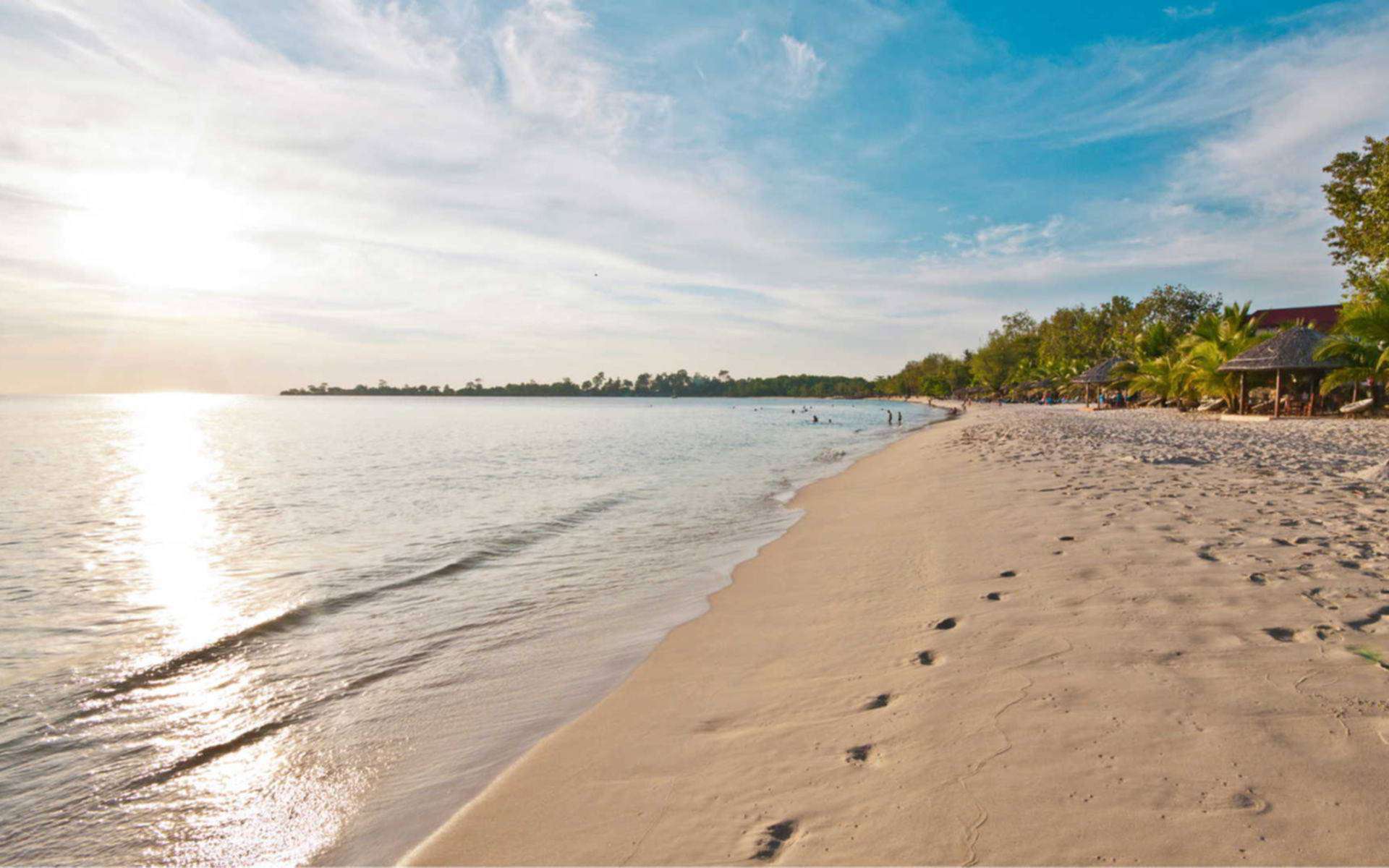 .
.
Curious about Sihanoukville? Let's take a quick tour to satisfy your wanderlust!
For those seeking unparalleled luxury, Sihanoukville boasts Cambodia's most prestigious resorts. The crown jewel is Song Saa Private Island, a secluded paradise famous for its over-the-top villas, impeccable service, and staggering beauty. This is a destination for business class vacations, where a night's stay can range from $3,000 to $5,000 depending on the season.
- Top Attractions: Sihanoukville boasts stunning beaches, including Serendipity Beach, Otres Beach, and Sokha Beach. For a tranquil escape, head to Koh Rong or Koh Rong Samloem islands, where crystal-clear waters await. Don't miss exploring Ream National Park for its diverse flora and fauna, or visiting the vibrant Otres Market for local crafts and delicious street food.
- Safety: Sihanoukville is generally safe for tourists, but it's always wise to keep your belongings secure and stay aware of your surroundings, especially in crowded areas and at night.
- Best Time to Visit Sihanoukville: The dry season, from November to March, offers sunny days and ideal beach weather. However, it's also peak tourist season, so expect more crowds. For fewer tourists and lower accommodation prices, consider visiting during the shoulder seasons of April to June or September to October.
- Activities: Dive into adventure with snorkeling, scuba diving, or kayaking in the pristine waters. Discover the region's cultural heritage by exploring local pagodas or taking a boat trip to nearby islands. Indulge in fresh seafood at bustling seafood markets or unwind with a beachside massage.
- Accommodation: From luxurious beach resorts with panoramic ocean views to cozy beach bungalows and budget-friendly hostels, Sihanoukville offers accommodation options to suit every traveler's preference and budget.
- Getting Around: Tuk-tuks and taxis are readily available for short trips around town or to nearby attractions. Renting a scooter or bicycle provides flexibility for exploring at your own pace, while ride-hailing apps offer convenient transportation options. Walking along the beach promenade or exploring the town's vibrant streets on foot is also a delightful way to soak in the local atmosphere.
5. Battambang
Battambang, Cambodia's second-largest city, is a treasure trove of history, culture, and natural beauty. Nestled on the banks of the Sangkae River, it's a place where time slows down, and visitors can immerse themselves in the authentic Khmer way of life. The city's charm lies in its French colonial architecture, vibrant markets, and friendly locals, making it a must-visit for anyone exploring the Kingdom of Wonder.
For those seeking adventure, the legendary bamboo train offers a unique ride through lush landscapes, while the Phnom Sampeou mountain is home to the infamous Killing Caves, a poignant reminder of Cambodia's past. The bat caves at dusk provide a spectacular natural display as thousands of bats swarm out into the evening sky.
Culinary explorers will delight in Battambang's street food, where local delicacies like Lort Cha and Bai Sach Chrouk can be savored. The city's creative scene is flourishing, with art galleries and craft markets showcasing the talents of local artisans.
Safety is a priority, and visitors can feel secure as they wander through the city's streets and countryside. The best time to visit is between October and January when the weather is cooler and the rice fields are a vibrant green.
Accommodation options are plentiful, ranging from cozy guesthouses to luxurious resorts, ensuring a comfortable stay for all. Cultural shows, such as those performed by Phare, the Cambodian Circus, offer insight into the country's artistic heritage.
Transportation is convenient, with tuk-tuks and motorbike rentals available for exploring the city and its surroundings. For a serene experience, a boat tour on the Sangkae River reveals the beauty of the riverside landscapes.
A visit to Battambang is incomplete without exploring its historical sites, including the well-preserved temples and the Governor's Residence. To fully appreciate the city's offerings, a stay of at least three days is recommended, allowing ample time to experience its attractions, cuisine, and culture.
Curious about Battambang? Here's a snapshot to pique your interest:
- Top Attractions: The Bamboo Train, Phnom Sampeou with its Killing Caves, the lively Phsar Nath Market, and the serene Sangkae River.
- Safety: A safe haven for travelers, just exercise the usual precautions.
- Best Time to Visit Battambang: The cool season from October to January is ideal, though the city welcomes visitors year-round.
- Activities: Ride the bamboo train, explore historical sites, sample street food, and enjoy cultural performances.
- Accommodation: From quaint homestays to elegant hotels, there's a place for every traveler.
- Getting Around: Navigate with ease using tuk-tuks or rent a bike for a more personal experience.
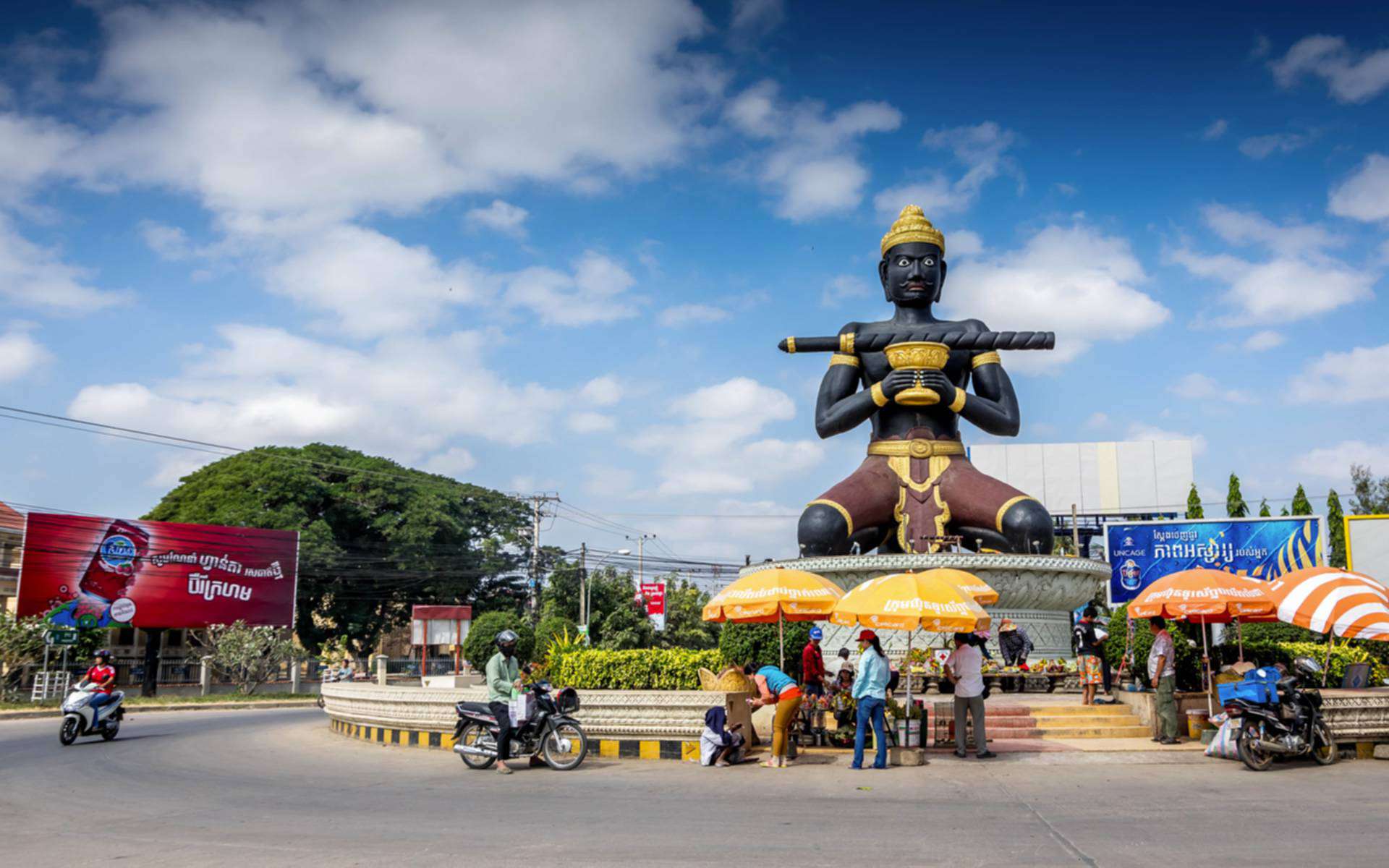
6. Tonlé Sap Lake
Tonlé Sap Lake, known as the 'Great Lake' of Cambodia, is a unique ecological marvel. It is the largest freshwater lake in Southeast Asia and a vital part of Cambodia's natural heritage. Located in the heart of the country, it is connected to the Mekong River through the Tonlé Sap River, which intriguingly reverses its flow depending on the season. This phenomenon contributes to the lake's size variation, where it can expand up to five times during the wet season, providing a rich habitat for over 200 species of fish and numerous bird species, making it an excellent spot for bird watching.
The name 'Tonlé Sap' translates to 'River Lake', reflecting the fusion of river and lake ecosystems. The lake is a freshwater body, pivotal to the livelihood of over a million Cambodians who reside in the surrounding provinces. These communities have ingeniously adapted to the lake's rhythms by constructing floating villages that rise and fall with the water levels. These villages, such as Chong Khneas, Kampong Phluk, and Kampong Khleang, offer a glimpse into the resilient and resourceful way of life that has flourished here.
The Tonlé Sap Biosphere Reserve is an area designated by UNESCO to protect the diverse ecosystems and species that the lake supports. It is a sanctuary for endangered waterbirds and a testament to the lake's global environmental significance.
Visitors to Tonlé Sap Lake can explore by boat, navigating through the floating villages and witnessing the daily lives of the local communities. While there are no significant dangers associated with visiting these areas, it is always advisable to be mindful of the environment and respect the local customs and practices.
The best time to visit Tonlé Sap Lake is during the dry season, from November to May, when the water levels are lower, and the villages are more accessible. However, the wet season offers its own allure, with lush landscapes and the lake at its most expansive.
In summary, Tonlé Sap Lake is not just a tourist destination; it's a living, breathing community where the water dictates the pace of life. It's a place where visitors can witness the harmonious coexistence of humans and nature, and where the wonders of Cambodia's great lake can be fully appreciated. Whether you're an avid birdwatcher, a curious traveler, or someone seeking to understand the essence of Cambodian life, Tonlé Sap Lake is a destination that truly encapsulates the beauty and complexity of this Southeast Asian nation.
7. Kep and Kampot
Nestled in the southern reaches of Cambodia, the twin towns of Kampot and Kep offer a blend of serene landscapes, colonial architecture, and culinary delights that beckon travelers seeking an authentic Cambodian experience. Kampot, with its riverside charm, is renowned for the world-famous Kampot pepper, while Kep, a tranquil coastal retreat, is synonymous with succulent seafood and its iconic Crab Market.
In Kampot, visitors can explore the remnants of French colonial elegance and venture into the Bokor National Park, where the abandoned Bokor Hill Station whispers tales of a bygone era. The park's lush landscapes and cooler climate provide a refreshing contrast to Cambodia's tropical warmth. A journey through Kampot's countryside reveals verdant pepper plantations and salt fields, offering a glimpse into the region's agricultural heritage.
Kep, once a favorite seaside getaway for the French elite, now invites travelers to relax on its quiet beaches or hop on a boat to the nearby Rabbit Island (Koh Tonsay) for a day of sun and sea. The town's Crab Market is a must-visit, where the day's fresh catch is served right by the water's edge, offering a feast for the senses.
For those planning to visit both towns, the proximity of Kampot and Kep makes it feasible to experience their unique offerings within a single trip. Whether it's a leisurely bike ride through Kampot's streets or a tuk-tuk adventure along Kep's coastline, getting around is part of the adventure. The region's safety, coupled with the warm hospitality of its residents, ensures a welcoming atmosphere for all who wander here.
Visitors typically allocate several days to fully immerse themselves in the local culture, cuisine, and natural beauty. With a range of accommodations from riverside bungalows to beachfront resorts, there's a place to suit every traveler's preference and budget.
To encapsulate the essence of these Cambodian gems:
- Top Attractions: Bokor National Park's historical ruins, Kampot's pepper plantations, Kep's Crab Market, and the serene beaches of Koh Tonsay.
- Safety: Both towns are considered safe for visitors, with common-sense precautions recommended.
- Best Time to Visit Kep and Kampot: The dry season from November to April offers ideal weather, while the off-peak months provide a quieter experience.
- Activities: From exploring historical sites and natural parks to indulging in the freshest seafood and pepper-infused dishes, there's plenty to do.
- Accommodation: A variety of stays await, from cozy guesthouses to upscale resorts, catering to all tastes and budgets.
- Getting Around: Rent a scooter, hire a tuk-tuk, or take a leisurely bike ride to discover the scenic beauty at your own pace.
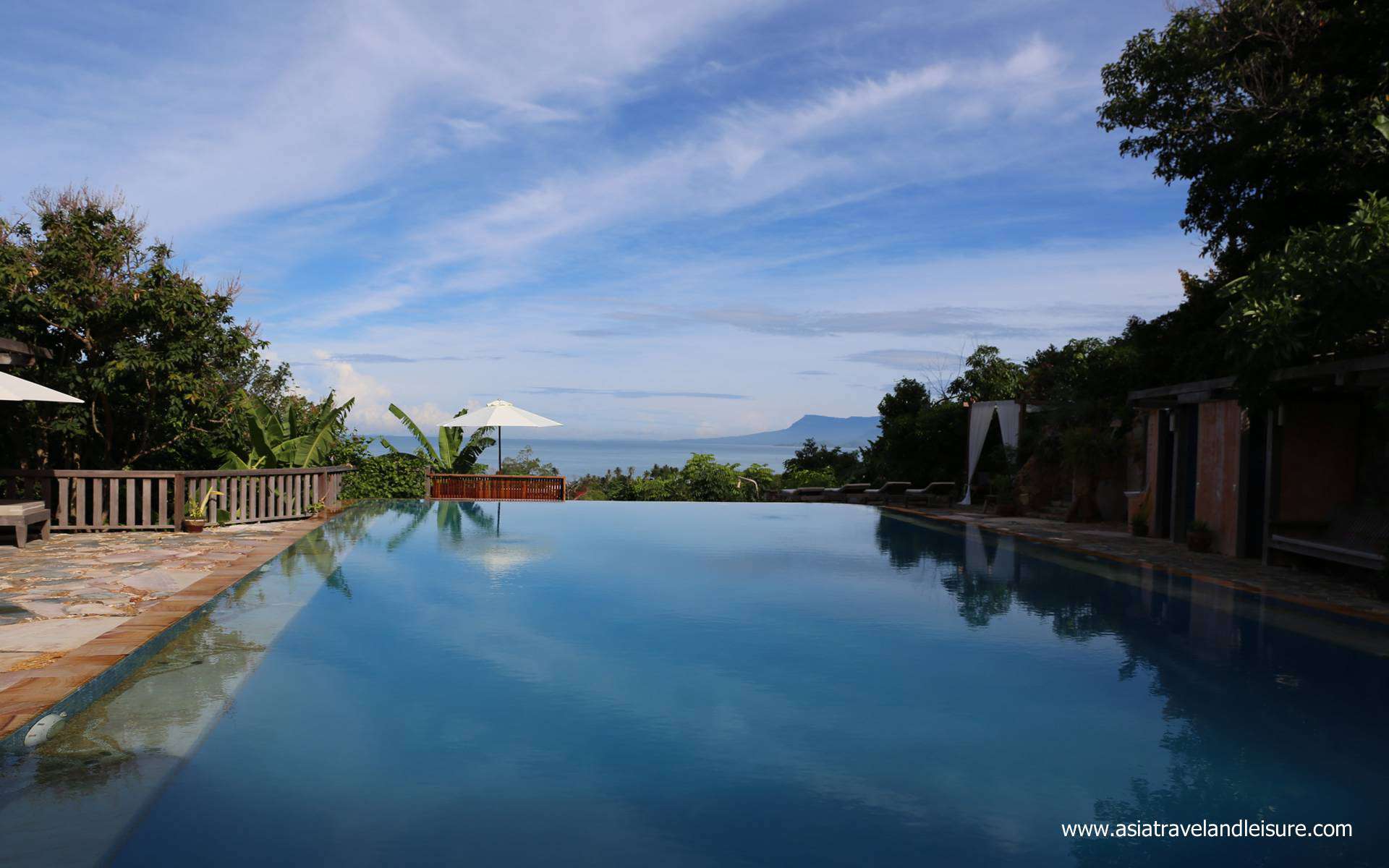
8. Kratie
Kratie, a serene riverside town in Cambodia, is a treasure trove of natural beauty and cultural heritage. Nestled along the banks of the mighty Mekong River, it offers a tranquil escape from the hustle and bustle of city life. Visitors are drawn to Kratie for its laid-back charm and the opportunity to witness the rare Irrawaddy dolphins gracefully navigating the waters. A visit to the Mekong Turtle Conservation Centre reveals the dedicated efforts to protect endangered species, where one can learn about the conservation work and even participate in turtle releases during certain times of the year.
Go to the east of Cambodia and you will have a opportunity to immerse in a similarly languid riverside ambience and spot the freshwater Irrawaddy dolphins. These rare majestic creatures can be found deep in the Mekong that is close to the Kampi village and about 15 km north of Kratie. Dolphin-watching trips can also be easily combined with a visit to the lovely hilltop meditation centre of Phnom Sambok and the temple and turtle conservation center at Sambor town while the chance to experience the rural Cambodia life in Koh Trong with a unique floating village and a few white and sandy beaches in Kratie may tempt you to linger longer. This is also an ideal place to enjoy the finest sunsets at the Mekong Rivers. The colors, the reflections of sunset and the quiet and peaceful Kratie will give you unforgettable memory in your Cambodia tour.
The town's historical allure is encapsulated in sites like Wat Sray Sahn, known for its spiritual significance, and the 100-Column Pagoda, a marvel of traditional architecture with a rich history dating back to the Chenla period. Phnom Sambok, with its ancient temples, offers panoramic views of the surrounding landscape and a glimpse into Cambodia's past.
For those seeking a more immersive experience, the island of Koh Trong, a short ferry ride away, presents an idyllic setting for cycling through orchards and exploring traditional Khmer homesteads. The Kampi Rapids near Kratie are perfect for a refreshing swim or a leisurely boat tour, providing a unique perspective of the region's natural splendor.
A visit to Kratie can be a brief yet fulfilling part of a Cambodian adventure, with two to three days being sufficient to soak in its highlights. However, its allure often entices visitors to linger longer, basking in the peaceful rhythm of river life.
Need a brief insight into Kratie? Here's a quick rundown to satisfy your curiosity:
- Top Attractions: The enchanting Mekong River, home to the elusive Irrawaddy dolphins; the Mekong Turtle Conservation Centre; Wat Sray Sahn; the 100-Column Pagoda; and the scenic Phnom Sambok.
- Safety: Kratie is generally safe for tourists, with the usual precautions advised.
- Best Time to Visit Kratie: The cooler months from November to February are ideal, offering comfortable weather for exploration.
- Activities: Spotting Irrawaddy dolphins, visiting conservation centres, exploring ancient temples, cycling on Koh Trong Island, and swimming in the Kampi Rapids.
- Accommodation: A range of options from riverside guesthouses to comfortable hotels caters to all preferences.
- Getting Around: The town is easily navigable by bicycle, tuk-tuk, or on foot, allowing for a leisurely pace to take in the sights and sounds of this charming locale.
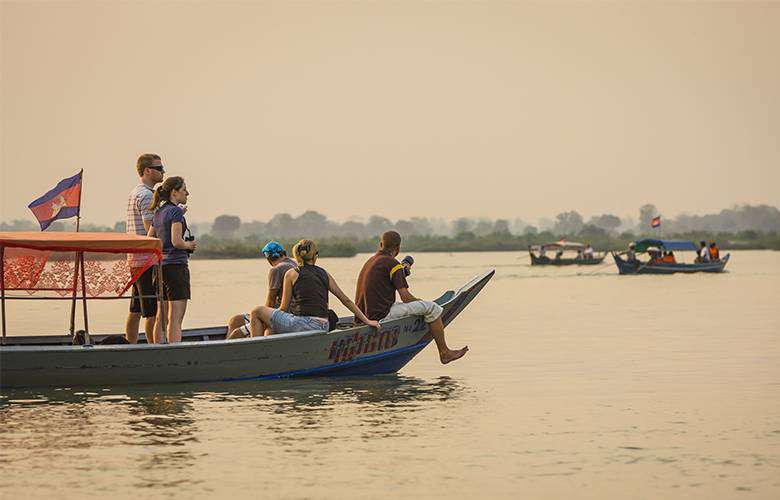
9. Preah Vihear
Get away from the crowds of Angkor Temples, tourists can visit a unique architectural complex of a series of sanctuaries in Preah Vihear. The Temple of Preah Vihear is an outstanding masterpiece of Khmer architecture, in terms of plan, decoration and relationship to the spectacular landscape environment. It is a 9th century temple complex atop a 500-meter high mountain on the border between Cambodia and Thailand which has an unusual layout for a Khmer temple, with four enclosures laid out in a row. Due to its remote location, this site is particularly well preserved.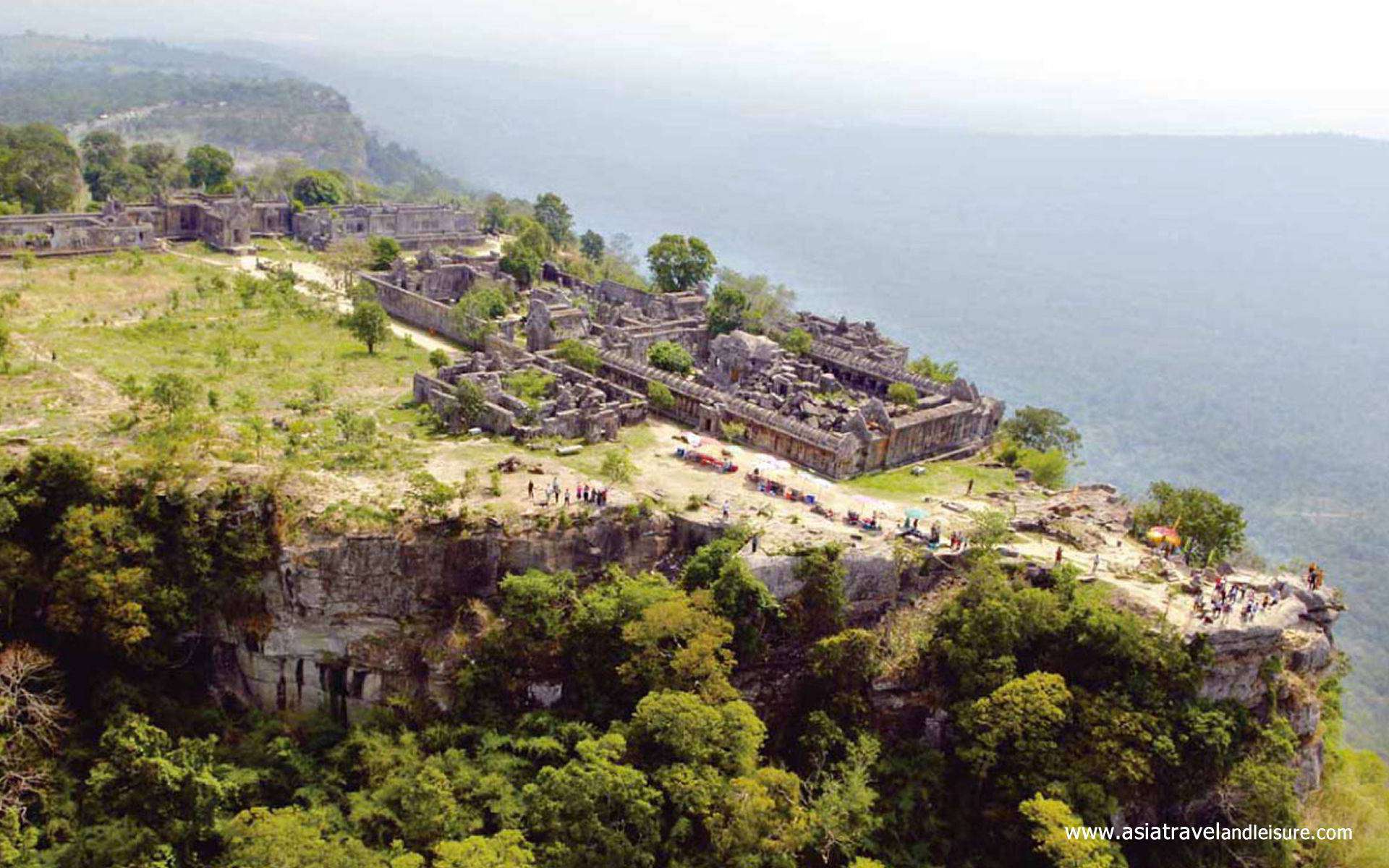
10. Mondulkiri Province
Mondulkiri Province, nestled in the northeastern corner of Cambodia, offers a serene escape into nature's embrace. From lush forests to majestic waterfalls and vibrant wildlife sanctuaries, there's no shortage of experiences to cherish in this picturesque region.
Top Attractions: Discover the allure of Mondulkiri Province through its captivating attractions. Embark on an adventure to Bou Sra Waterfall, a mesmerizing cascade where you can cool off with a refreshing swim amidst the tranquil surroundings. For an enchanting hike, explore the scenic trails leading to Chrey Thom Waterfall, especially breathtaking during the rainy season when the waters flow gracefully. Don't miss the chance to encounter Cambodia's diverse wildlife at Phnom Prich Wildlife Sanctuary, home to an array of species including elephants, gibbons, and various bird species.
Safety: Mondulkiri Province is generally safe for visitors, but it's advisable to exercise caution, especially when exploring remote areas or embarking on outdoor activities. Stay informed about weather conditions and heed any warnings issued by local authorities.
Best Time to Visit: The ideal time to visit Mondulkiri Province is during the dry season, from November to March, when the weather is pleasant and rainfall is minimal. However, if you prefer fewer crowds and don't mind the occasional rain shower, consider visiting during the shoulder seasons of April to June or September to October.
Activities: Immerse yourself in the natural beauty of Mondulkiri Province with a myriad of activities. Experience the unique culture of Pou Lung Village, where you can engage with the local community and learn about their traditional way of life. For an unforgettable encounter with gentle giants, volunteer at the Elephant Valley Project and witness these majestic creatures roam freely in their natural habitat. Don't forget to hike to the summit of Yok Don Kraom for panoramic views of the surrounding landscape and a sense of achievement.
Accommodation: Whether you seek luxury or budget-friendly options, Mondulkiri Province offers a range of accommodations to suit every preference. From cozy guesthouses nestled amidst lush greenery to eco-friendly resorts with stunning vistas, you'll find the perfect place to rest and rejuvenate after a day of exploration.
Getting Around: Getting to Mondulkiri Province is an adventure in itself. While there are no direct flights, you can opt for a scenic bus journey from Phnom Penh or Siem Reap. Once you arrive, tuk-tuks and taxis are readily available for short trips around town or to nearby attractions. For a more immersive experience, consider renting a motorbike or bicycle to explore the charming villages and verdant landscapes at your own pace.
Experience the enchanting beauty and rich cultural heritage of Mondulkiri Province, where every moment is an opportunity for discovery and wonder.
Cambodia is a truly remarkable destination that offers a diverse array of experiences for travelers. From the awe-inspiring Angkor temple complex to the stunning coastal regions and charming countryside, this Southeast Asian gem has something to captivate every visitor. By exploring the top destinations highlighted in this guide, you'll uncover the cultural richness, natural beauty, and warm hospitality that make Cambodia such a special place. Whether you're seeking ancient history, outdoor adventures, or culinary delights, this country is sure to leave a lasting impression. Start planning your unforgettable journey to Cambodia today and immerse yourself in the wonder of this enchanting land.
